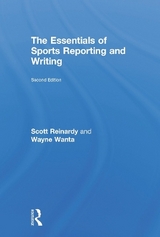
The Essentials of Sports Reporting and Writing
Routledge (Verlag)
978-0-8058-6447-2 (ISBN)
- Titel erscheint in neuer Auflage
- Artikel merken
This text covers the full experience of sports writing. Authors Wayne Wanta and Scott Reinardy approach the topic using their own professional experience as sports writers and editors to give students a realistic view of the sports writing profession. After the overview and introduction to sports journalism, the authors move into the stages of article writing, organized around article beginnings, middles, and endings. The text also covers other types of sports stories, such as columns, profiles, and news, and addresses style and ethics issues. It provides students with a full understanding of how to produce quality content for sports stories, as well as offer insights as to what to expect in the sports reporter position.
Scott Reinardy is an Assistant Professor of Journalism at the University of Kansas. His research interests include news reporting and writing, sports journalism, and newspaper management. He has more than 14 years experience as a professional journalist, working as a sports writer, editor and columnist on numerous local and regional newspapers. Wayne Wanta is a Professor in the School of Journalism at the University of Missouri - Columbia and was the 2006-2007 President of AEJMC. He has been an active researcher in political communication and media effects, particularly in the area of the agenda-setting function of the news media - how news coverage of issues influences the public's perceptions of those issues. Wanta has also conducted research in visual communication, sports journalism, Internet use and effects, and negative political advertising. Before entering the academic field, Wanta worked for eight years in newspapers, and has experience as a copy editor, page designer, and feature writer.
Chapter 1: Introduction: The field of sports writing; expectations; pros and cons of careers. (Wayne)
Chapter 2: Types of stories: Game reports, advances, follows, sidebars; features, personality profiles. (Wayne)
Chapter 3: Preparation: Getting ready, information sources. (Scott)
Chapter 4: Beginnings: What to lead with; history, quotes, key play, etc. (Scott)
Chapter 5: Beginnings: Types of leads; anecdotal, descriptive, delayed, etc. (Scott)
Chapter 6: Beginnings: Worst leads; One-word leads; etc. (Wayne)
Chapter 7: Middles; Story structures: Inverted pyramid, diamond structure, 1-3-4-2, etc. (Wayne)
Chapter 8: Middles: Effective interviewing (Scott)
Chapter 9: Middles: Getting good quotes; Transitions (Wayne)
Chapter 10: Middles: Play-by-play; too much, too little (Scott)
Chapter 11: Endings: What to end with (Wayne)
Chapter 12: Endings: What you need to include (Wayne)
Chapter 13: Other types of stories: Sidebars (Scott)
Chapter 14: Other types of stories: Advances and follows (Scott)
Chapter 15: Other types of stories: Columns (Wayne)
Chapter 16: Other types of stories: Features and profiles (Wayne)
Chapter 17: Other types of stories: Sports news (Scott)
Chapter 18: Some final points: Stylistic errors to avoid (Wayne)
Chapter 19: Some final points: Ethics of sports writing (Scott)
Chapter 20: Sports online
| Erscheint lt. Verlag | 17.2.2009 |
|---|---|
| Zusatzinfo | 4 Tables, black and white |
| Verlagsort | New York |
| Sprache | englisch |
| Maße | 152 x 229 mm |
| Gewicht | 606 g |
| Themenwelt | Sachbuch/Ratgeber ► Sport |
| Geisteswissenschaften ► Sprach- / Literaturwissenschaft ► Literaturwissenschaft | |
| Sozialwissenschaften ► Kommunikation / Medien ► Journalistik | |
| ISBN-10 | 0-8058-6447-4 / 0805864474 |
| ISBN-13 | 978-0-8058-6447-2 / 9780805864472 |
| Zustand | Neuware |
| Informationen gemäß Produktsicherheitsverordnung (GPSR) | |
| Haben Sie eine Frage zum Produkt? |
aus dem Bereich



